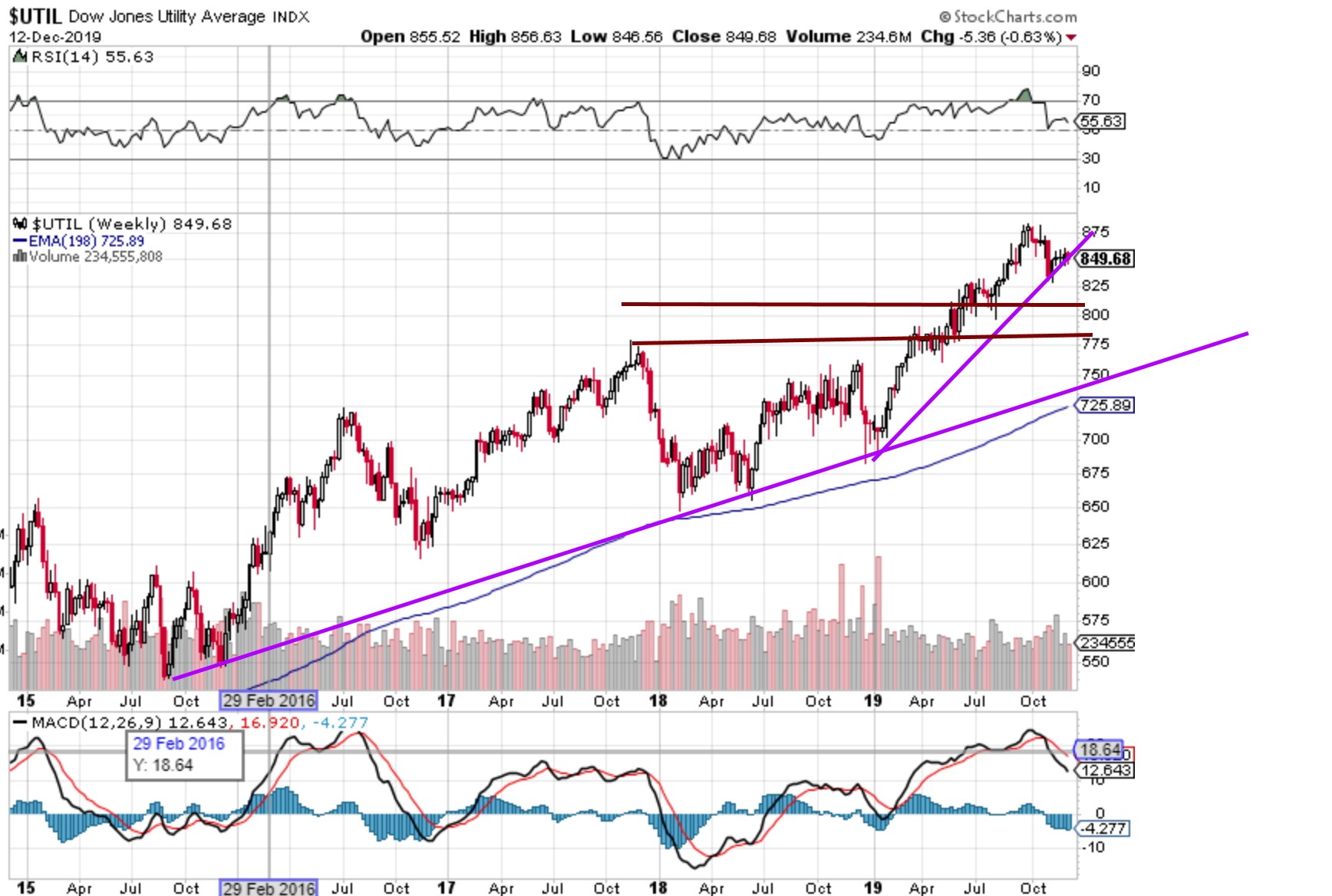
Dow Transports Service Dow 30K Prediction?
Are trading to let some steam out. Then the Dow is very likely to undergo a pullback according to the Tactical Investor’s Dow Theory if the pullback is powerful. From the market update, 9300 to 9600 ranges’ goals were to the Dow moves. The programs (as displayed in the preceding graph ) are very likely to check the 802 into 819 ranges using a potential overshoot into the 765 into 774 ranges.
Right off the bat, we’re likely to say that we’re in favour of a much correction unless the trend varies since it will produce a purchasing chance. The chart of this transports illustrates they are currently at a zone of immunity; since the transfers are trading at the ranges around the graphs shown below, this immunity will be overcome. The transfers will need to shut on monthly basis above 11250. If they can attain this, support will be turned into by then immunity. A breakout may push this indicator up to 1800 to 2400 points greater from the zone.

Ranges the breakout effort by the Dow transfers is very likely to fail. The reverse is going to transpire, although this will convince everybody that the transport sector is currently going to breakdown. If the trade is transported by the Dow the likelihood of a transfer to the 9300 to 9600 will spike. If it comes to pass traders may load up on stocks in the transport sector.
The total trend is upward, and when a business is despised, it is most likely the time to
set up positions. The setup would call the Dow will follow in its footsteps and in doing so produce an excellent prospect to experience a pullback. Until the trend varies, an individual needs to ignore the impulse to fear if the market’s pullback strongly. The proposed course of action is to split out a jar of your favourite drink (alcoholic or non-alcoholic) and observe. According short-term traders can observe the 801 costs will be indicated by a violation of the zone.
Our future views on Dow Jones Transportation Average
When the utility pullback the Dow Industrials and Transports are very likely to take the exact same route and in doing so this will produce a purchasing chance that is lovely for 2020. Opinion has inched up the following 2 points and it’s nearly. Readings are well below their average of 39. Overall market sentiment is currently signalling a solid pullback needs to be seen as a chance when it comes to pass. The
Dow is trading over 28k, and the sentiment is still trading under its historic average. Simply speaking, we could conclude that year’s market activity will capture 90 per cent of specialists with their trousers down. Of the experts, even people who obtained the first portion of the bull market, are currently wearing their feelings on their sleeves. Can we understand? All one must do is pay attention? In case you’ve got a prejudice (be it governmental or politics ), your vision is clouded and consequently your own analysis.
Some readers have asked us do not brief the markets; our attention is on the long-term trend. We could guarantee that it is not Once it appears like it’s simple to assess the direction of this trend. We do not wish to be in doing so miss out on both ends and in a place where we’re stuck considering two tendencies in two different time frames. We are reminded by this of this narrative of the donkey that maintained searching for a more tasty haystack; of starvation, the fool died ultimately.
Thus, while the trend is upward, we’ll concentrate on the transactions that are extended and vice versa. Notice the market upgrade is a tool which may be employed to satisfy your requirements; hence in the event that you have time and are comfy with the market, you might do so. The very best method to decrease the risk variable when shorting the market would be to use put options; you know upfront how much you can lose.
In short, there’s absolutely no reason to fear, and when this sale continues at
this speed it will cause a monstrous purchasing occasion and this is the kicker, those who panicked will overlook it, for after fear sets in; it’s quite tough to distinguish between chance and catastrophe. Think back to 2008, also look at missed the ship since the
premise was that the markets may go lower.
Now given the intensity of the present sell-off, the markets will likely mount a rally, the very first effort usually fails, and when the history is to be reliable then when this rally fizzles out, it ought to result in another downward tide, which could take the market to fresh highs on an intraday basis.
If the pattern is sufficiently powerful, we can issue a term open the place up or put play. That is where you place with different strike rates and opens both a phone. Do not neglect to maintain a trading diary; if blood is flowing on the roads, the very time is.
What do others think about Dow Jones Transportation Average?
What Is the DJTA?
What Is the Dow Jones Transportation Average?
The Dow Jones Transportation Average (DJTA), sometimes simply known as the “Dow Transports” is a price-weighted average of 20 transportation stocks traded in the United States. The Dow Jones Transportation Average is the oldest U.S. stock index, first compiled in 1884 by Charles Dow, co-founder of Dow Jones & Company.
The index initially consisted of nine railroad companies and only two companies from outside the railroad industry. That is a testament to the dominance of railroads in the U.S. transportation sector in the late 19th and early 20th centuries. In addition to railroads, the index now includes airlines, trucking, marine transportation, delivery services, and logistics companies.
Key Takeaways
The Dow Jones Transportation Average (DJTA) is a price-weighted average of 20 transportation stocks traded in the United States.
In addition to railroads, the index now includes airlines, trucking, marine transportation, delivery services, and logistics companies.
The Dow Jones Transportation Average is closely watched to confirm the state of the U.S. economy, especially by proponents of Dow Theory.
Changes in the DJTA are rare, and they usually only happen following a corporate acquisition or other dramatic shifts in a component’s core business.
Understanding the Dow Jones Transportation Average
Transportation is much less important to the overall stock market than it was when the DJTA was first created. However, transportation stocks can follow a different pattern than the rest of the market. Sometimes, they can help traders and investors to predict changes in the market. Read more
Why DOW Transportation Average Is Actually Pretty Good When It Comes to Stocks
The average is an everyday word. We use it without even thinking about it. We want to know the average temperature, our favourite player’s batting average, the average home price in a neighbourhood.
That got us thinking about the average stock. It is, after all, the Dow Jones Industrial Average. And it is helpful to know what Wall Street thinks average is. That way, investors can discern when Wall Street loves or hates, a stock.
The most average stocks Barron’s could identify in the S&P 500 and the Dow are FedEx and JPMorgan Chase, respectively. We had picked FedEx (ticker: FDX) as a Buy recommendation in 2019 and JPMorgan (JPM) was featured on a 2019 cover story.
But what does average mean for a stock?
For starters, the average market capitalization in the S&P 500 is about $60 billion, but the median market cap is $23 billion. The S&P is a little top-heavy. On average, 21 analysts cover an S&P stock. The average Buy-rating ratio—which is Buy recommendations divided by total recommendations—for stocks in the S&P is about 53%. The average Sell-rating ratio is about 7%. Analysts are far more likely to rate stocks they don’t recommend as Hold instead of Sell. And the average analyst price target for an S&P stock implies a gain of about 6%. Read more
Will Dow Transports Trip This Bull Market?
The bull market’s fate now rests on just 20 stocks.
I am referring to the 20 stocks that make up the Dow Jones Transportation Average. At least according to some interpretations of the venerable Dow Theory — the oldest stock market timing system that is in widespread use today –, the bull market will not be considered alive and well until this average rises above its previous all-time high.
And that’s asking a lot since the Dow Transports are 12% below that level.
Why would Dow Theorists believe that the fate of the market rests in the hands of just 20 stocks? Therein lies a long story that I told three weeks ago and will not repeat here. But, in a nutshell, Dow Theorists focus on the behaviour of both the Dow Transports and its better-known sister average, the Dow Jones Industrial Average. Bull markets are considered alive and well when both of these averages are jointly hitting new highs.
Three weeks ago these averages had their work cut out for them since both were far below their April highs. But it turns that just the Dow Industrials were up to the challenge; while last week they rose to a new intra-day record, the Dow Transports remain far behind.
If anything, in fact, they are getting even further behind. On Monday of this week, when the Dow Industrials rose slightly, the Dow Transports dropped another 155 points or 1.5%.
Other Articles of Interest

Bear Market nonsense: Experts want you to think Markets are Going to Crash

US Dollar Finally Hit Bottom?

Uranium Futures price chart

Sophistication in Sentiments: The Stock Market Emotions Chart Explained

The Artful Approach to Winning the Stock Market Game

Harnessing Power: The Dynamic Approach of Small Dogs Of the Dow

Psychology Unveiled: Exploring the Depths of the Human Mind

What happens if the stock market crashes?

Achieving Financial Goals with Intelligent Investing Strategies

Stock market performance 2019

Quantitative Easing Definition

Stock Market Update

Stock Market Quotes and Sayings


